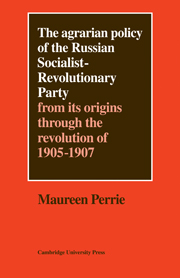 The Agrarian Policy of the Russian Socialist-Revolutionary Party
The Agrarian Policy of the Russian Socialist-Revolutionary Party Book contents
- Frontmatter
- Contents
- Preface
- Acknowledgements
- Note on dates and transliteration
- Map of regions and guberniyas of European Russia
- Introduction
- Part I From Populism to the SR party (1881–1901)
- Part II The campaign for the peasantry (1902–1904)
- Part III The revolution of 1905
- Part IV The aftermath of revolution (1906–1908)
- 12 The party approves its programme
- 13 Splits in the party
- 14 The SR agrarian programme in the first two Dumas
- 15 The commune, socialisation, and the Stolypin reforms
- 16 Party activity in the countryside
- Conclusion
- Glossary
- Bibliography
- Index
16 - Party activity in the countryside
Published online by Cambridge University Press: 07 October 2011
- Frontmatter
- Contents
- Preface
- Acknowledgements
- Note on dates and transliteration
- Map of regions and guberniyas of European Russia
- Introduction
- Part I From Populism to the SR party (1881–1901)
- Part II The campaign for the peasantry (1902–1904)
- Part III The revolution of 1905
- Part IV The aftermath of revolution (1906–1908)
- 12 The party approves its programme
- 13 Splits in the party
- 14 The SR agrarian programme in the first two Dumas
- 15 The commune, socialisation, and the Stolypin reforms
- 16 Party activity in the countryside
- Conclusion
- Glossary
- Bibliography
- Index
Summary
The Stolypin coup d'état of 3 June 1907 brought to an end the period of semi-constitutional activity which the SRs had enjoyed during the existence of the First and Second Dumas. In this period the party had been able to agitate widely and openly among the masses, and the relaxation of censorship had enabled them to publish a range of books, journals and newspapers in Russia. In the period of the First Duma, a dozen SR publishing houses were in existence in Russia, issuing over twenty daily and weekly newspapers. In St Petersburg and Moscow, 200 titles of books and pamphlets were published, about 4 million copies in all. Because of police harassment, the main party newspaper had to change its title several times, appearing successively as Delo Naroda (‘The cause of the people’), Narodnyi Vestnik (‘Popular herald’), Golos (‘Voice’), and Mysi' (‘Thought’); 30 out of the 55 numbers printed were in fact confiscated, but 43,000 copies of the remaining issues were distributed. After the dissolution of the First Duma, the party press went underground again, although a small legal journal continued to survive under the titles Narodnyi Vestnik, Soznatel'naya Rossiya (‘Conscious Russia’), Novaya Mysl' (‘New thought’), and Nasha Mysl' (‘Our thought’). From October 1906 the central party organ was again published illegally, with the title of Partiynyya Izvestiya.
- Type
- Chapter
- Information
- The Agrarian Policy of the Russian Socialist-Revolutionary PartyFrom its Origins through the Revolution of 1905–1907, pp. 185 - 195Publisher: Cambridge University PressPrint publication year: 1977


